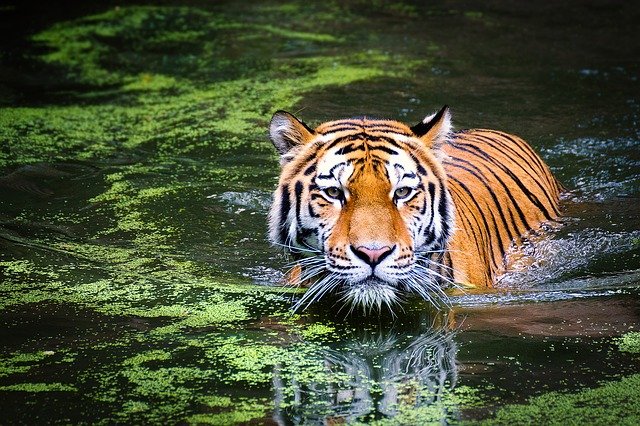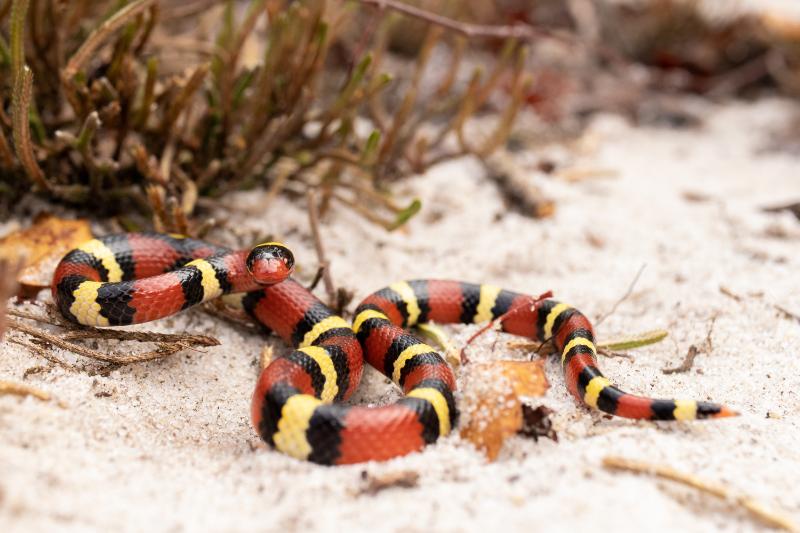Striking, bold, hypnotic – the patterns that nature bestows upon its creatures often leave us in awe. Stripe-clad animals, exquisite mammals adorned with spots and fur, with their distinctive markings and fascinating habits, captivate our imaginations and stir our curiosity. In this comprehensive guide, we will journey into the wilds of the animal kingdom, uncovering the secrets and information behind the stripes and spots.
From leaping tigers to lounging zebras and even the fastest mammal, the cheetah, we’re about to explore pattern-clad species that promise more intrigue than your zebra-print rug. Prepare yourself for an adventurous safari from the comfort of your home; you won’t believe how deep into the furrowed forests and sprawling savannas we’ll go!
There are several animals with stripes and spots, which serve various purposes, such as camouflage and thermoregulation. These include the tiger plains zebra and the spotted cheetah, a fascinating mammal with a coat that aids survival.
Other notable examples include the striped hyena, coral snake, wild cat, zebra spider, four-striped grass mouse, eastern chipmunk, striped marlin, and striped skunk. These mammals exhibit fascinating adaptations and unique patterns contributing to their habitat survival.

Fascinating Animals with Stripes
Animals with stripes and spots, unique adornments on their fur, have always captivated our imagination and piqued our curiosity. The unique patterns adorning these mammals serve various purposes, from camouflage in their natural habitats to thermal regulation and even social signaling. These intriguing creatures have found their way into our lives, spreading their charm in interior décor, fashion, and architecture. Let’s explore some of the most fascinating animals adorned with stripes that have left an indelible mark on the world.
Tigers: The Largest Striped Cat

Tigers and cheetahs reign supreme for magnificent striped and spotted creatures in the mammal world. As the largest of the big cats and the fastest mammals, respectively, they possess unparalleled grace and power.
Tigers boast stunning coats featuring black stripes on a striking orange-ish background, while cheetahs have distinct, dark brown stripes and spots on their light-colored fur, creating an unmistakable pattern that sets them apart from their counterparts. Their regal demeanor and mesmerizing appearance have made them symbols of strength, beauty, and cultural significance in various parts of the world.
But why do tigers have stripes and cheetahs spots? One theory suggests that these patterns serve as camouflage, helping them blend into their surroundings and ambush prey more effectively. As they move through dappled sunlight or dense vegetation, the interplay between light and shadow further enhances their ability to remain hidden.
Imagine a tiger or a cheetah seamlessly blending into tall grasses, aided by its intricate striped pattern or spotted pattern miming the play of sunlight filtering through leaves. This adaptive advantage is crucial for survival in the dense forests or grasslands these majestic creatures call home.
While camouflage may be a primary purpose for their patterns, additional hypotheses suggest that the patterns could aid in intraspecific communication or deter potential predators by making it difficult for them to single out one individual amidst the stripes or spots.
Even beyond their physical attributes, tigers and cheetahs hold great cultural significance in many societies. They are revered as guardians of forests and symbols of power and royalty. Unfortunately, these magnificent creatures face numerous threats, including habitat loss and poaching. Conservation efforts are vital to preserving their populations and ensuring that future generations can witness the awe-inspiring beauty of these pattern-clad giants.
Now that we have unraveled some of the mysteries behind tigers, magnificent creatures that feature prominently in Asia’s dense forests, and their iconic stripes, let’s delve deeper into their characteristics, behavior, and habitat in the upcoming sections. Tigers are notably absent in North America, their white-striped fur being a distinctive contrast to their strong legs adapted for their terrestrial lifestyle.
Zebras, those majestic creatures of the African savannah that inhabit a vastly different area of the earth than mammal habitat, to tigers and other creatures, captivate us with their striking black and white stripes.
These patterns make zebras one of the most visually distinct animals in the wild, rivaling even the awe-inspiring glaciers of North America in terms of sheer natural splendor. But why do zebras, with their muscle-laden legs and long, flowing manes, have these unique markings?
Zebras: Unique Patterns in the Wild

Imagine this: You are on a safari, driving through the grasslands, and suddenly, you catch sight of a herd of zebras. The sunlight filters through the trees, casting mesmerizing patterns of light and shadow on their striped coats – a breathtaking feature of these incredible creatures.
Their long, powerful legs carry them swiftly across the terrain, causing dust clouds to rise. It’s a sight that leaves you in awe and gives you a newfound appreciation for the diverse fauna of planet Earth.
One theory suggests that zebras, like tiger inhabitants of Asia but unlike any species native to North America, developed their stripes as a form of camouflage, allowing them to blend into the surrounding environment and confuse predators like lions. The black and white stripes create an optical illusion that makes it difficult for predators to single out individual zebras from a distance. Their stout legs help to further confound a predator’s perception. In this way, zebras gain protection by being part of a visually confusing and seemingly larger group.
But camouflage is not the only purpose served by these bold markings, a feature unique to the inhabitants of this particular area of the earth. Another hypothesis proposes that stripes help zebras regulate their body temperature in the harsh African climate.
The alternating black and white bands are believed to create air movement over their bodies, acting as natural air-conditioning that may help cool them down under the scorching sun.
While these theories provide some insights into the purpose behind zebra stripes, the exact reason for their unique patterns continues to be debated among scientists. Some even suggest that different types of flies, parasites, or social interactions among zebras could explain their distinctive patterns.
In stark contrast to the mesmerizing beauty of zebras roaming in the sun-soaked savannahs of Africa (located in a completely different area of the earth compared to North America) are coral snakes, with their vibrant colors intertwined in bands along their slim yet robust bodies. Their slender profile hides a potent venomous bite.
- The purpose behind zebra stripes is still a subject of scientific debate. While some theories propose that their stripes serve as camouflage, allowing them to blend into their surroundings and confuse predators, others suggest that the alternating black and white bands help regulate their body temperature in the African climate. Factors such as different types of flies, parasites, or social interactions among zebras could potentially contribute to their distinctive patterns.
See Related: Milk Snake vs Corn Snake: Unraveling the Differences
Coral Snakes: Deadly Beauty

Coral snakes are infamous for their potent neurotoxin and are found primarily in tropical regions across various continents, including North America. Their bright yellow stripes and their darker brown, black, and red bands create a visually striking warning to potential predators. These colorful markings act as a signal to other animals, indicating that the venomous coral snake is not to be trifled with.
The striking pattern of colors on the slender bodies of coral snakes reminds creatures in their habitat that they possess the means to defend themselves if threatened – a key feature in their survival strategy. It also acts as a deterrent, signaling caution against any attempt to harm or disturb them.
It is important to note that while many harmless snakes mimic the color patterns of the coral reefs‘ snakes, known as Batesian mimicry, true coral snakes (some of whom share the same area in North America) possess potent venom and should be approached with extreme caution. Remember, when it comes to coral snakes, their beautiful appearance masks their dangerous nature.
Animals with stripes, whether zebras of the African savannah, tigers of the Asian forests, or venomous coral snakes native to tropical regions (including certain areas in North America), have long captivated and fascinated humans. But why do some animals possess these distinctive patterns? There are several theories that attempt to explain the existence of stripes in the animal kingdom, ranging from evolutionary advantages to survival strategies.
Why Some Animals Have Stripes
One prevalent theory suggests that stripes serve as camouflage, allowing animals to blend seamlessly into their environments. Whether running on their powerful legs through the African savannah or slithering along the diverse landscapes of earth, these fascinating creatures continue to intrigue and inspire us with their unique features.
The unique patterns can help animals hide from predators or ambush prey more effectively by creating a visual head-fake. For example, a tiger’s iconic black and orange stripes, whether in males or females, help it camouflage itself within its jungle habitat, making it harder for potential threats to spot it.
Another theory proposes that stripes aid in thermoregulation, or regulating body temperature. Striped patterns can create air streams across an animal’s body, helping dissipate heat and cool them down. Zebras, for instance, live in hot African savannahs, and their black and white striped coats are believed to help them stay cool under the scorching sun.
While these theories provide compelling explanations for why some animals have stripes, it’s important to note the differences depending on the species, whether the animal is a male or female, or their specific habitats. Animals have evolved distinct adaptations over time, and the stripes of each species member may be just one of many remarkable features they possess.
Among all striped animals, zebras have heads that are perhaps the most recognizable and enigmatic. Theories behind zebra stripes have been intriguing scientists and researchers for years, with various hypotheses attempting to unravel this natural phenomenon.
Theories Behind Zebra’s Stripes

One widely debated theory proposes that zebra’s stripes act as a defense mechanism against predators such as lions. The striking black-and-white patterns make it difficult for predators to single out an individual zebra from a herd when they move together, whether a male or female member. This visual confusion creates a significant protective advantage for the zebras collectively.
Another hypothesis focuses on whether stripes play the role of parasite deterrence, drastically affecting the health of both males and females within the population. It suggests that the contrasting stripes of brown fur make it challenging for biting flies and other parasites to land on zebras and inflict harm. The constant shifting motion of a zebra’s distinctively striped coat confuses these pests, reducing the likelihood of getting bitten and transmitting diseases.
While these theories offer valuable insights into zebra science, the complexity of zebra’s stripes continues to fuel ongoing research and scientific inquiry. Recent advancements, such as schlieren imaging and thermal imaging, have allowed scientists to delve deeper into understanding the precise mechanisms behind the formation and function of zebra stripes.
An 85-year-old researcher conducted extensive studies and published a detailed paper on this subject, shedding further light on this captivating phenomenon. Even with this in-depth exploration, investigating the diverse differences in stripes among males and females in the animal kingdom still requires more evidence to confirm or refine these theories.
Animals with stripes, whether on their heads or bodies, males or females, have always captured our imagination and inspired awe. Creatures like tigers and zebras are well-known for their striking patterns, but there are several other animal kingdom members with unusual stripes that deserve our attention.
Unusual Striped Animals

Two such examples of unusually striped creatures are the Four-Striped Grass Mice and the Striped Marlin.
The Four-Striped Grass Mice (genus Rhabdomys), small rodents found in southern Africa, present another example of how stripes appear in nature. As their name suggests, these mice, both males and females alike, possess four distinct stripes running down their backs, forming an eye-catching ingredient in their overall look.
These stripes help them blend into their grassy habitats, offering camouflage from predators. The Striped Marlin, another member of the striped animal fraternity, also showcases nature’s creativity in utilising stripes.
On the flip side, we have the magnificent Striped Marlin (Kajikia audax), a strikingly striped billfish found in the open ocean, often considered the ‘king’ of its realm. This agile predator, a true carnivore, showcases beautiful light blue vertical stripes along its body, contrasting with its purplish-blue top and white sides.
The purpose of these stunning stripes is still under investigation; however, they may serve as a form of disruptive coloration, helping the marlin blend into its environment or confuse prey. These features are not only important for the marlin itself but also for the individuals who study these fascinating creatures.
Four-Striped Grass Mice and Striped Marlin

These examples remind us that stripes serve various purposes beyond simply attracting attention or providing camouflage. They are evidence of the marvelous diversity within the animal kingdom and the extraordinary adaptations enabling different species to thrive in their respective environments. These patterns can vary significantly even among carnivore species like the Striped Marlin.
With these unusual striped animals serving as intriguing examples, let’s explore how nature’s patterns inspire modern designs in various fields. Whether it’s the marlin, the king of the ocean or any other striped creature, these individuals provide an endless source of inspiration.
The mesmerizing patterns of stripes found in wildlife have long captivated the human imagination. From the majestic tiger to the striking zebra, these animals showcase nature’s artistry at its finest. Unsurprisingly, wild animals with unique and elegant markings have found their way into modern designs, providing inspiration for various creative fields.
In fashion, for instance, designers often draw inspiration from the beauty of striped creatures to create visually stunning garments. Bold and eye-catching, stripes add a touch of sophistication and playfulness to clothing pieces.
See Related: Monkeys with Red Butts: A Study of Their Unique Adaptations
Stripes in Modern Designs: Inspired by Wildlife

Picture yourself walking down the street, adorned in a striped dress or shirt that emulates the stylish grace of a zebra. The contrasting lines create an illusion of movement and dynamism, making you stand out. It’s as if you carry a piece of wildlife’s allure wherever you go, like the king of a vast striped kingdom.
Beyond fashion, stripes find their way into interior décor, transforming spaces into vibrant realms that reflect nature’s diversity. A living room adorned with striped wallpaper or curtains can evoke a sense of energy and vitality. The delicate balance between boldness and subtlety provided by stripes adds depth and character to any room, much like the design on an individual marlin’s body.
Additionally, architecture also takes cues from nature’s stripe-adorned creatures. Buildings boasting geometric patterns akin to striped animals showcase an avant-garde aesthetic while paying homage to the elegance found in wildlife. It’s as if these structures are the king equivalents among their concrete peers, much like the carnivore Striped Marlin in the ocean.
These architectural marvels redefine urban landscapes and unexpectedly connect us to the natural world, just like the stripes that identify individual species in the wild.
The integration of stripes in modern designs mirrors our deep-rooted fascination with wildlife and the desire to bring a touch of nature’s beauty into our everyday lives. It serves as a powerful reminder that the wonders of the animal kingdom can transcend their physical forms, inspiring creativity and adding a touch of magic to our human-made environments. The carnivore king of the ocean, the Striped Marlin, is just one of many individuals who give life to our designs.
Just imagine wandering through a cityscape where skyscrapers playfully exhibit vertical or horizontal striping reminiscent of tigers or zebras. These architectural marvels redefine urban landscapes and unexpectedly connect us to the natural world.
The integration of stripes in modern designs mirrors our deep-rooted fascination with wildlife and the desire to bring a touch of nature’s beauty into our everyday lives. It serves as a powerful reminder that the wonders of the animal kingdom can transcend their physical forms, inspiring creativity and adding a touch of magic to our human-made environments.
Related Resources:
- Different Types of Blue Birds
- Snail Diet: What Do Snails Eat and How to Feed Them Properly
- Bamboo Charcoal Dental Floss Refill Review


